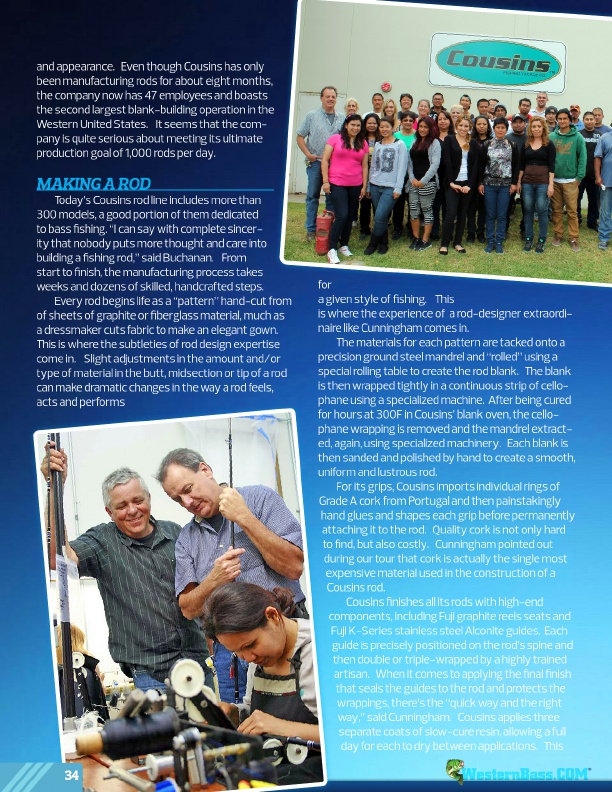
and appearance. Even though Cousins has only been manufacturing rods for about eight months, the company now has 47 employees and boasts the second largest blank-building operation in the Western United States. It seems that the com- pany is quite serious about meeting its ultimate production goal of 1,000 rods per day.
MAKING A ROD
Today’s Cousins rod line includes more than 300 models, a good portion of them dedicated to bass fishing. “I can say with complete sincer- ity that nobody puts more thought and care into building a fishing rod,” said Buchanan. From start to finish, the manufacturing process takes weeks and dozens of skilled, handcrafted steps.
Every rod begins life as a “pattern” hand-cut from of sheets of graphite or fiberglass material, much as a dressmaker cuts fabric to make an elegant gown. This is where the subtleties of rod design expertise come in. Slight adjustments in the amount and/or type of material in the butt, midsection or tip of a rod can make dramatic changes in the way a rod feels, acts and performs
34
for a given style of fishing. This is where the experience of a rod-designer extraordi- naire like Cunningham comes in.
The materials for each pattern are tacked onto a precision ground steel mandrel and “rolled” using a special rolling table to create the rod blank. The blank is then wrapped tightly in a continuous strip of cello- phane using a specialized machine. After being cured for hours at 300F in Cousins’ blank oven, the cello- phane wrapping is removed and the mandrel extract- ed, again, using specialized machinery. Each blank is then sanded and polished by hand to create a smooth, uniform and lustrous rod.
For its grips, Cousins imports individual rings of Grade A cork from Portugal and then painstakingly hand glues and shapes each grip before permanently attaching it to the rod. Quality cork is not only hard to find, but also costly. Cunningham pointed out during our tour that cork is actually the single most
expensive material used in the construction of a
Cousins rod.
Cousins finishes all its rods with high-end
components, including Fuji graphite reels seats and
Fuji K-Series stainless steel Alconite guides. Each
guide is precisely positioned on the rod’s spine and
then double or triple-wrapped by a highly trained
artisan. When it comes to applying the final finish
that seals the guides to the rod and protects the
wrappings, there’s the “quick way and the right
way,” said Cunningham. Cousins applies three
separate coats of slow-cure resin, allowing a full
day for each to dry between applications. This
®